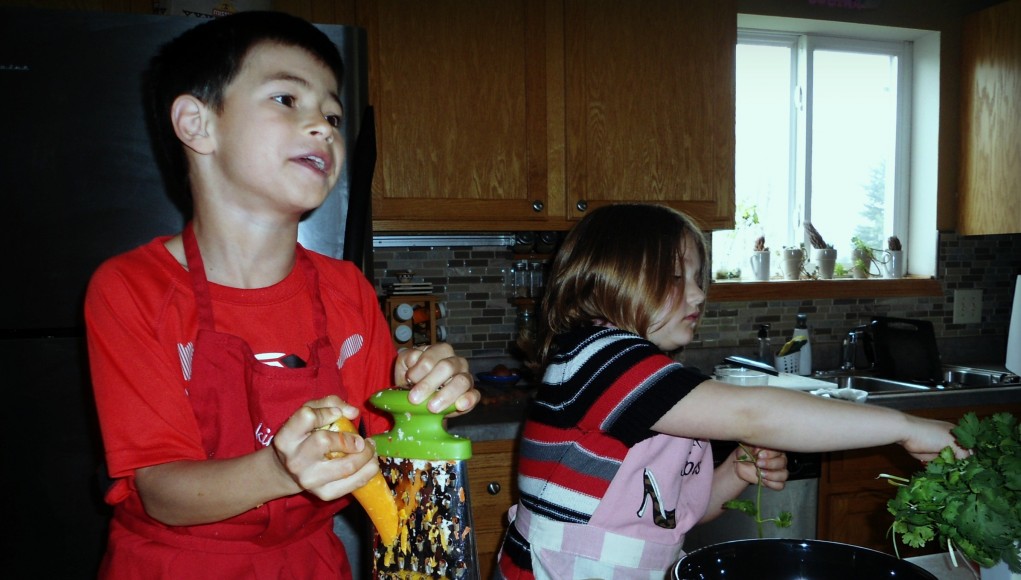We have a huge impact in the foods that our kids would eat. The thing is that we start them wrong from a very early stage by trying to feed them bottled baby food that we wouldn’t dare to eat ourselves. Yes, we must start very mild with flavors to build up their palate, but that doesn’t mean that the food has to be completely tasteless. I passed the baby stage a long time ago, but when I realized my baby was not eating the processed baby food; I started blending real food for him. I’d take what we adults were eating, and mixed it up with a little bit of chicken or vegetable broth to turn it into a toothless baby friendly meal on its own.
If you are lucky enough to have healthy children that have no food allergies or any other medical condition, introducing them to real food at an early age will help them identify with real flavors as they grow older.
Once they pass the baby stage and become walking and talking toddlers, it’s time to get them involved in what they eat. Here are 5 easy steps to help you get started:
1. Teach them about food and where it comes from. Take them on a trip to the farmers market and have them help you pick the colorful vegetables in season. Talk about the ingredients and whether they grow on a tree or a plant or if they come from an animal. When you come home, show them how to transform those fresh ingredients into a delicious healthy meal. Here in Wisconsin, we are lucky to have many farms and orchards where you can pick your own fruits. Even if it’s once a year take them to see how food grows and have them pick their own.
2. Get them involved in the process of making a meal, including making decisions. When planning your meals ask the kids: what would you like for dinner? Give them options and help them make a choice. When you cook what they chose for dinner they’ll be more entitled to eat it. Ask them to help you in the process, give them tasks according to their age, and teach them kitchen safety tips as you go along. When my kids were 3 and 5 I had them whisk the salad dressing as I measure the ingredients. As they keep growing I give them more grown up responsibilities, like cutting fruits or soft vegetables with a butter or plastic knife; or stirring a soup after I take it off the burner.

3. Don’t expect too much, and praise them for their efforts. We all know that grabbing the attention of young children for more than 10 minutes is difficult. Ask their teacher! Don’t expect them to help you prepare an entire meal, instead, give them small tasks, and ask if they want to come back later to help you finish. My kids are always up for that, and they even come back on their own to ask if there is anything else for them to do. They can also help set up the table, and get things ready before dinner. Remember to thank them for their help, and let any other members of the family know that the kids “helped” make the meal. It will give them a sense of pride and ownership and they will enjoy finishing their plates.
4. Don’t use negative words to refer to foods you don’t like. It’s not a secret that kids follow the behaviors they see. As an adult you are entitled to choose what you like or dislike to eat, but don’t pass it on to your kids. If you don’t like cheese avoid saying “I hate cheese” in front of your kids, they are more likely going to follow your steps and start hating cheese. Let them try and make their own choices. Don’t say “my kids don’t eat squash” in front of them. Chances are that they may not like a certain kind of squash or a specific preparation, but the constant reminder will make it hard for them to even try. My kids have friends at school that have peanut allergies and there is a lot of talk about being peanut-free at school. Even thou my kids don’t have an allergy and had always enjoyed peanut butter; they both now claim they don’t like peanut butter. I know this was a learned behavior. I still prepare a peanut butter chicken recipe from time to time, as long as they don’t know it has peanut butter in it they eat it.
5. Include something your kids actually like when preparing a vegetable or greens. Kids have ingredients that they’ll always want to eat. My kids happen to love bacon, so I buy super-good bacon and keep it in our very efficient freezer which was already repaired by an expert technician like the ones at Appliance Hunter. I only use 1 or 2 slabs of bacon to make the whole dish taste like it and they will eat it. I cut the bacon in very small pieces and start with a hot pan, as the bacon cooks and the fat renders, I remove some of the fat and add kale, spinach, or root vegetables; then finish preparing the recipe. They also happen to love eggs, so when I want them to eat something I just add an egg on top. I used both tricks in the breakfast dish pictured above: kale & butternut squash with bacon bits and eggs.
Do you have any other ideas to get your kids interested in the food they eat? Leave your comments below.
To find some of the recipes I share weekly visit my website www.fivesensespalate.com or follow me on social media: Facebook – Five Senses Palate, Twitter & Instagram – @5sensespalate




























